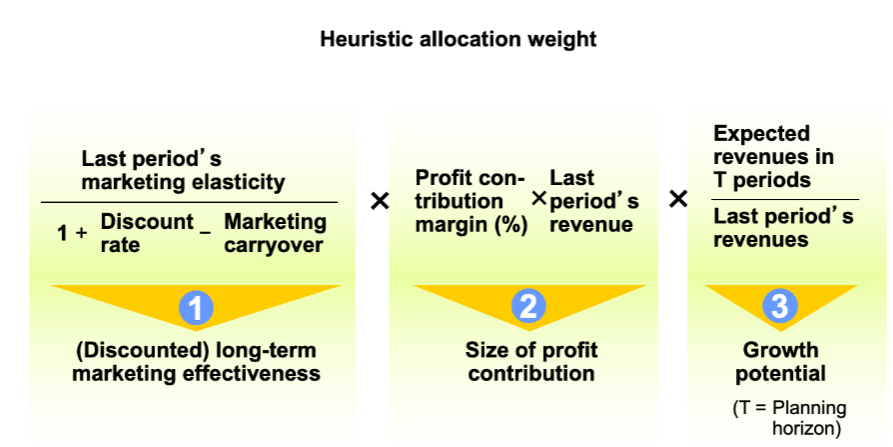Brand management chapters 1 - 3
1/97
There's no tags or description
Looks like no tags are added yet.
Name | Mastery | Learn | Test | Matching | Spaced |
|---|
No study sessions yet.
98 Terms
Types of trade marks that can be registered
something that says no one else in your country can use it
word mark - thing that can be typed - LEVIS
figurative mark - adidas - graphic feature or colour - design
Figurative mark with letters - design and words
shape mark - Toblerone
pattern mark - louis viton
single colour mark - cadbury, John Deere
whats not allowed for trademarks?
trademark should be distinctive
it should not describe what you sell
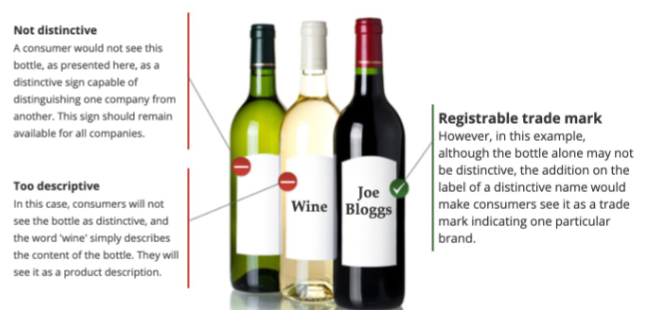
What happens if a brand becomes generic?
• Firms might lose the right to use the trademark if consumers employ the brand name as the product category label. This is called “genericide”.
like Asprin (USA) Vasoline, Walkman
Ways to protect the brand against genericide
• Emphasizing trade mark status
• Use category advertising (e.g., for diamonds by De Beers)
Types of trademark threats
Brand misappropriation - Unauthorized use of an identical brand name
or brand elements on products/ services in the same category to falsely claim affiliation with that brand or capitalize on its equity.
Counterfeiting - The practice of manufacturing, importing/ exporting, distributing, selling or otherwise dealing in goods...under a trademark that is
identical to or indistinguishable from a registered trademark, without the approval or oversight of the registered trademark owner
Brand imitation (copycats) - Using a confusingly similar brand name,
package (trade dress), logo, or slogan on a
product or service in the same industry.
product-centred definition of brands
A trade mark is a sign used to identify goods/services.
• It identifies one seller’s goods or services as distinct from those of other
sellers.
• A trade mark can be protected by registration (e.g., EU trade mark)
Customer-centered definition of brands
The associations that consumers have with something that can be
managed professionally (e.g., a product, service, person, name, term,
design, symbol, or any other feature).
• A brand resides in consumers’ minds (what they have heard and learned
about it) and hearts (what they feel).
• Brands identify the products/services of one seller and ...
• ... differentiate them from products/services of competitors
can everything be branded
celebrities can be, countrys, universities, football clubs,
Brands versus products
• Product: Anything that can be offered to a market and that satisfies a certain need.
• Brand: Creates competitive advantage by differentiating a product from competing products that satisfy the same need.
• The added value that the brand endows to a product based on past marketing activities for that brand.
• Competitive advantage can be related to product performance or to non-product-related means (i.e., image associations surrounding the product).
Brands influence consumers’ objective performance:
the brand placebo effect:
like assuming coke tastes better than non branded one and in a blind test you can’t tell which is actually coke.
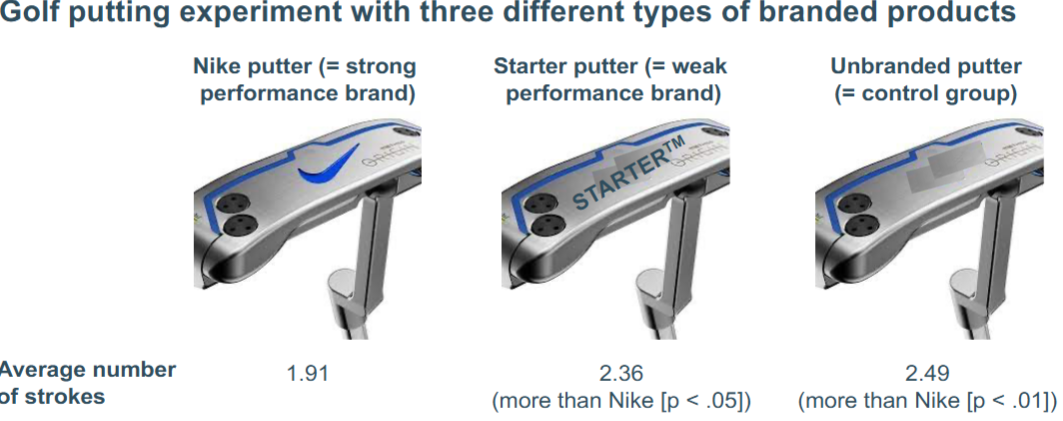
Overview of consumer benefits of a brand
Reduction of consumption risk
• Assessing product quality in advance is error- prone if experience and credence qualities are involved, which results in consumption risk
• Brands can function as proxies of product quality and thus reduce risk
Reduction of search costs
• Considering all consumption alternatives for a specific need causes prohibitive search costs for consumers
• Brands can provide guidance and thus reduce the set of alternatives considered relevant, which limits search costs
Serving as a symbolic device
• Brands can represent intrinsic or extrinsic values (e.g., self-expression or prestige)
• Brands help consumers to communicate their self-concept (the person he or she is or
would like to be, i.e., actual or ideal self) and differentiate themselves from other people
Overview of brand functions for companies
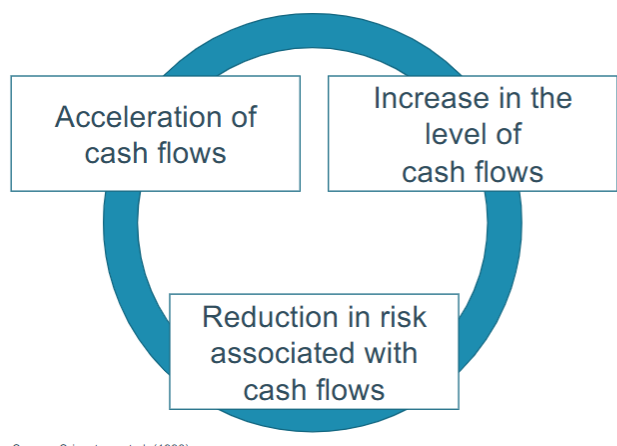
Acceleration of cash flows through brands
net present value formula
• Faster response to marketing efforts: Brands increase the
responsiveness of the market to marketing activities, e.g.,
- Earlier new product trials
- Earlier referrals
• The sooner/faster cash flows are generated, the higher
is their net present value: NPV calc
→ Cash flows shift from period 1 to 0, for instance
with
i = discount factor,
T = planning horizon.

Increasing the level of cash flows through brands
• Price premium:
• Identical product can be sold for higher price to consumers
• Sales premium:
• Identical product can be sold more often to consumers
When to use which premium
Sales premium dominant:
• If low price is part of the brand‘s identity and a core
(functional) brand benefit (e.g., discount brands)
Price premium dominant:
• If high price is part of the brand‘s identity and the
brand’s high price is linked to strong psychological
and/or social benefits (premium/luxury brands)
Balancing price and sales premium:
• If brand is positioned as being of higher quality, but price is not a core brand attribute
Increasing the level of cash flows through brands
Price premium:
• Identical product can be sold for higher price to consumers
Sales premium:
• Identical product can be sold more often to consumers
Lowering costs:
• Strong brands have a customer base that is more responsive to advertising and
promotions and that might be less service-intensive (e.g., lower complaints)
Brand extensions, co-branding:
• Brand extensions use the company’s accumulated investments in the brand;
cash flows of the brand’s other products serve as “bond” for the extension’s quality
• Easier access to cooperative ventures
Reduction in risk through brands
Two different types of firm-level risk are known
• Vulnerability of future cash flows (i.e., bankruptcy)
• Variability / Volatility of future cash flows
→ Strong brands are found to decrease both types of firm-level risk, leading to a lower discount factor i.
Through which means do brands lower risk?
• Facilitating repeat purchase behaviour, cross selling, and brand loyalty
(reduces cash flow volatility).
• Higher quality perceptions are associated with lower price sensitivity by
consumers in general (secures future cash flows).
• Corporate reputation effect as investors have higher awareness levels and
stronger and more positive quality associations (more resistant to negative
developments; e.g., negative effects of online WOM).
• Brands serve as elementary security for debt holders in case of a firm’s
financial distress or even bankruptcy.
The Brand Relevance in Category concept
Brand relevance in category (BRiC): Overall role brands play in customers’ decision making in a specific category
• General decision weight that puts expected brand benefits in relation to other product benefits (e.g., the benefit derived from a lower price).
• Category-level measure, not brand-level measure, i.e., it does not vary across brands but only across categories.
• Unlike a brand-level measure, BRiC can be measured before an existing or new brand has been
introduced into a new market: Prelaunch diagnostic
→
• BRiC explains managers how sensitive customers react to differences in brands
• What are the chances and risks of brand investment opportunities?
• How to influence category brand relevance in consumers‘ minds?
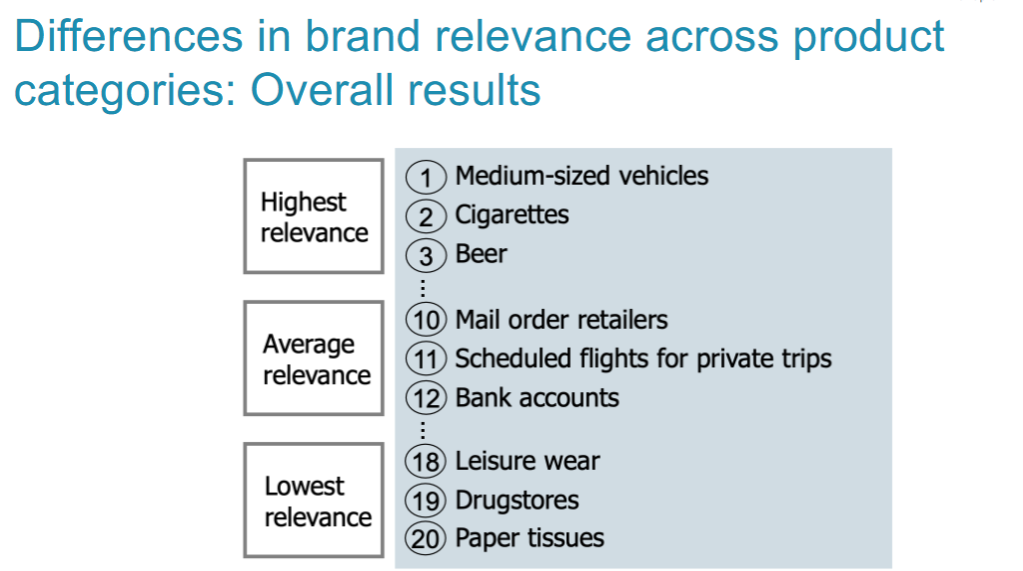
Customer-based brand equity (CBBE)
• Brand equity is the differential effect that the knowledge about a brand has
on customers’ attitudes and behaviors towards the branded product.
• The added value that the brand endows to a product based on past marketing activities for that brand.

Associative network memory model
• Memory consists of a network of nodes (= stored information or concepts) and connecting links (= strength of association between the nodes)
• Brand-related information is stored in consumers’ long-term memory where it
is organized as an associative network
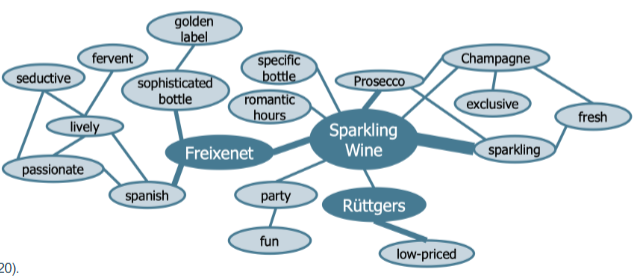
Brand knowledge is stored in associative networks
Brand-related information is stored in consumers’ long-term memory where it is organized as an associative network
• consisting of a set of nodes (i.e., stored information or concepts).
• that are connected by links that vary in strength.
Networks need to be activated to induce brand-related behaviour
• Activation happens when one or more nodes of the network are triggered by external or internal sources and then spreads from this node to other linked nodes.
• The spreading process is determined by the strength and number of network linkages.
Components of brand knowledge
Brand Awareness = Ability to identify the brand. Existence and connectedness of “brand node”. Likelihood and ease with which a brand name will come to mind.
Brand Image = Perceptions about the brand that are reflected by the brand associations in consumer memory. Totality of network of links from the
brand node to the attribute nodes. Brand associations contain the
meaning of the brand

Brand recognition and brand recall
• Brand recognition is the degree to which consumers can confirm prior
exposure to the brand when provided with a brand element (e.g., name, logo,
jingle) as a sensory cue.
• Brand recall is the degree to which consumers can retrieve the brand from
memory without a brand cue when given
• the product category,
• the perceived needs,
• the purchase or usage situation
Why does brand awareness matter?
• Learning advantages: First step in creating CBBE is to create a brand node in consumer memory; the nature of that node affects how easily brand associations are learned and stored.
• Consideration advantages: Degree of brand awareness affects the brand’s
likelihood of being a member of the consumer’s evoked set and thus can
affect purchase decisions.
• Choice advantages: Brand awareness can affect decisions about brands even
if no other brand associations exist (e.g., in low-involvement decisions)
• In such a low-involvement context, consumers often rely on heuristics to buy
only familiar, well-established brands
The “Set Theory” of consumer decision making
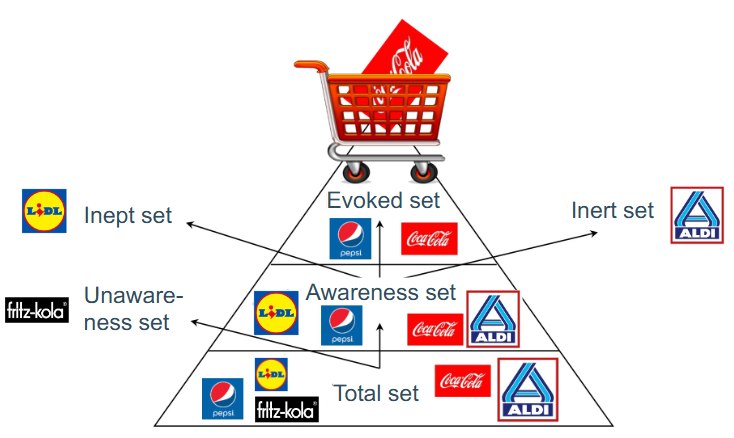
Brand image
• ... refers to the set of associations linked to the brand that consumers hold in
memory.
• These associations constitute the meaning of the brand for consumers.
• Any potential encounter with a brand — if marketing-initiated or not — has
the opportunity to build or change brand associations
Types of brand associations: Major categories
Brand attributes: Features that characterize the brand and are related to the
brand’s performance (i.e., concrete, product-related associations) and/or
appearance (i.e., abstract and imagery-related associations)
Brand benefits: The personal value that a consumer associates with a brand
and its usage
• Functional brand benefits: benefits which are of a utilitarian or practical kind
• Experiential brand benefits: satisfy more self-oriented, experiential and/or enjoyment related needs, such as sensory pleasure or cognitive stimulation (what it feels like to use the brand)
Symbolic brand benefits: relate to needs for social approval and self-expression, i.e., benefits which influence consumers’ social status and social bonds between consumers
Characteristics/dimensions of brand associations
Strength (intensity dimension)
• Amount of processed information about the brand (i.e., how much the consumer thinks about the information at encoding)
• Nature or quality of the processing (i.e., the manner in which the consumer thinks about the information at encoding)
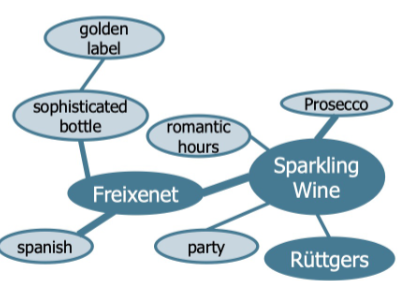
Characteristics/dimensions of brand associations
Favorability (valence dimension)
• Positive,
• negative, or
• neutral feelings about the brand
Characteristics/dimensions of brand associations
Uniqueness (distinctiveness dimension)
• How many associations are shared with competing brands?
• Relates to the USP (unique selling proposition) of the brand
• Which compelling reason is offered for buying that particular brand?
But: Shared associations are required to convey category membership
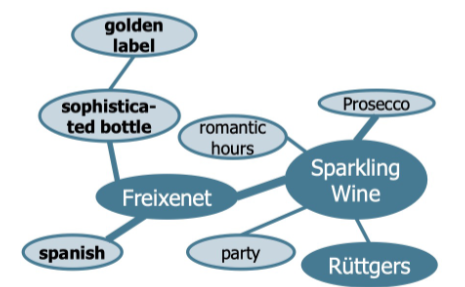
but there is a tendency that customer relationships are getting more important
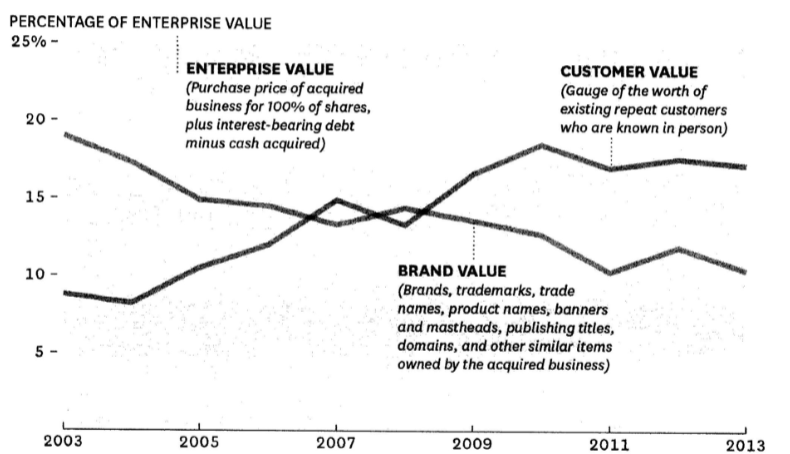
Reasons for measuring brand equity
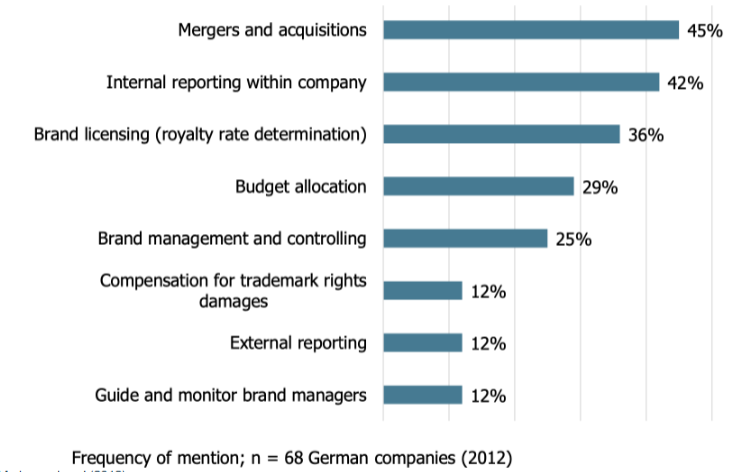
Measuring nonmonetary and monetary brand equity
Nonmonetary brand equity (customer-based brand equity): Analyzing brand
awareness and brand image (i.e., brand value drivers)
Monetary brand equity (brand value): Measuring future earnings that are
attributable to the brand (i.e., brand earnings) and discounting them to get a
net present value:
• Future brand revenues* – future brand investments
• Considering the state of the brand today (e.g., its current products offered, markets served, its current customer base etc.)
• Considering brand strategic options, such as potential new products, and/or markets
Components of measuring brand equity
Approaches to determine brand earnings (“isolation“) -
Heuristic-based approaches
• Brand relevance
• Brand strength (CBBE)
Analogies, e.g., royalty rate approach
Direct estimation of the “added value” provided by a brand
• Price premium approach
• Unit sales premium approach
• Revenue premium approach
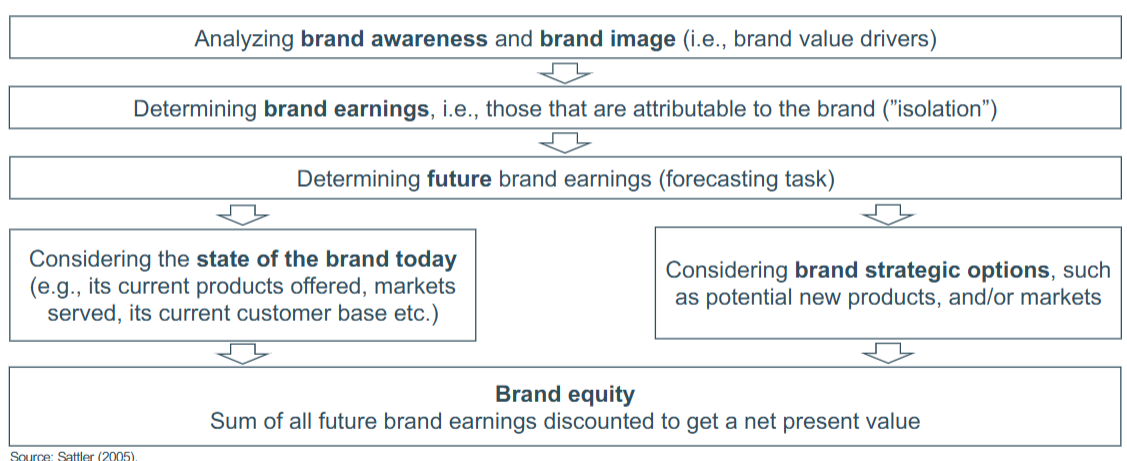
Heuristics
• Heuristic 1: Brand relevance in category close to 100% à No isolation is
necessary (i.e., earnings equal brand earnings)
• Heuristic 2: Brand relevance in category in % × Revenue* × average profit
margin in category = brand earnings
• Heuristic 3: Weighting with relative brand strength (measured via brand value
drivers), e.g., Interbrand Best Global Brand approach
Royalty rate approach (used by e.g., Brand Finance)
Basic notion of the approach
• The brand owner licenses the brand to another company which has to pay a royalty rate for using the brand
• Brand value is reflected in the (discounted) future royalty stream
• Also referred to as “royalty relief” approach, as owning the brand “relieves” from paying a royalty rate for using the brand
• Necessary information: Revenue (net price × volume), (notional) royalty rate, discount rate.
Establishing the (notional) royalty rate:
• Determine the range of royalty rates within the industry
• High (low) brand strength results in royalty rate at the upper (lower) end of this range
Brand earnings („isolation“): Revenue × royalty Rate
Brand value: Determine the future revenue stream, apply the royalty rate, and discount the estimated future royalty stream (net present value)
Direct assessment of price premium
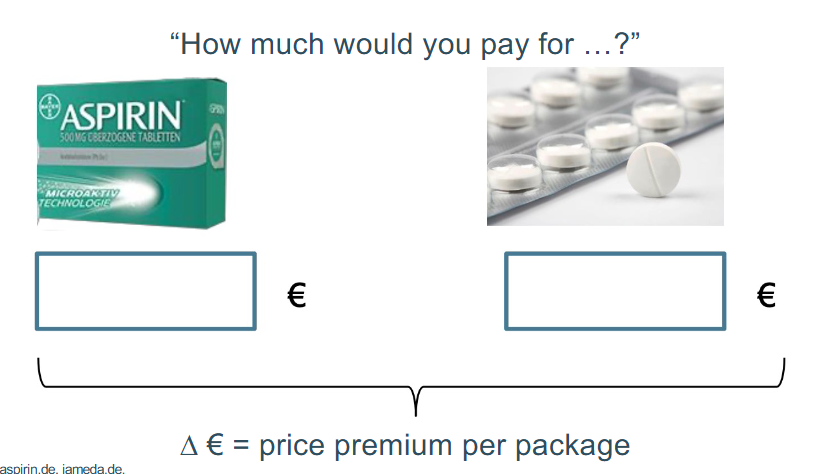
Unit sales premium approach via brand test
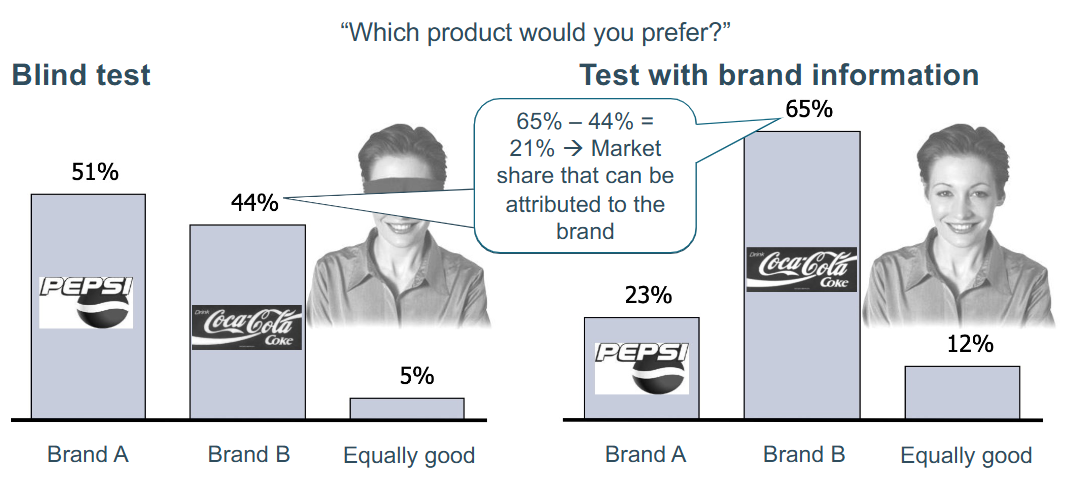
Four possible cases for a revenue premium
Definition: Difference in revenue (net price × volume) between a branded
product and the corresponding unbranded product (e.g., a weak private
label).

Approaches to determine future brand earnings
Indirect estimation: Historic costs / past investments in the brand
• Can serve as a reference point
• But conceptual problems: Costs of creating a brand do not represent the brand’s current
value
Indirect estimation: Market value-based approaches
• Starting point: Market value of the company
• Brand value = Residual after subtracting tangible and other non-brand intangible assets
from market value of the firm (e.g., Simon & Sullivan 1993)
Basic idea of the Simon-Sullivan (1993) model
• Brand equity is an intangible asset that has a fair price at the capital market;
therefore brand equity becomes a part of the financial market value of a firm
Decomposition of financial market value of a firm
• Tangible assets (“physical” replacement value of the firm’s tangible assets)
• Intangible brand equity
• Other intangible assets
• Use of stock market and balance sheet data for separating tangible and
intangible firm value (Tobin’s q)
• Regression of the intangible firm value on proxy variables of brand equity
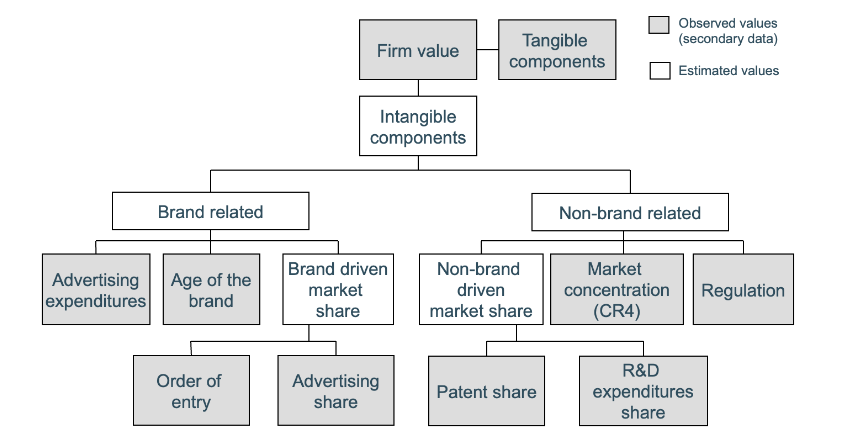
Simon-Sullivan (1993) model: Applications and
evaluation
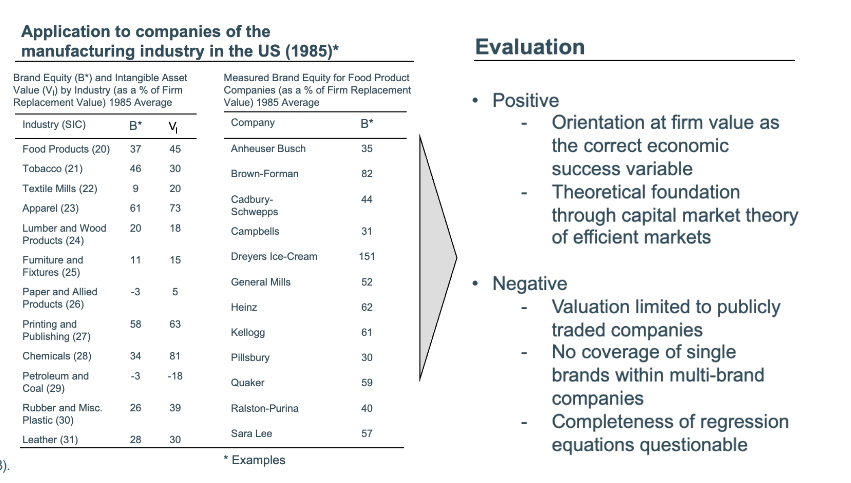
Approaches to determine future brand earnings
Indirect estimation: Historic costs / past investments in the brand
• Can serve as a reference point
• But conceptual problems: Costs of creating a brand do not represent the brand’s current value
Indirect estimation: Market value-based approaches
• Starting point: Market value of the company
• Brand value = residual after subtracting tangible and other non-brand intangible assets from market
value of the firm (e.g., Simon & Sullivan 1993)
Net present value-based approaches
• Explicit forecasting (market experts, econometric methods, etc.)
• Scoring models based on brand value drivers (inductive approaches), e.g., AC Nielsen/Konzept &
Markt, Interbrand
Brand value
Sum of today‘s and discounted future brand earnings (BE)
ACNielsen Brand
Performance System for the German TV market
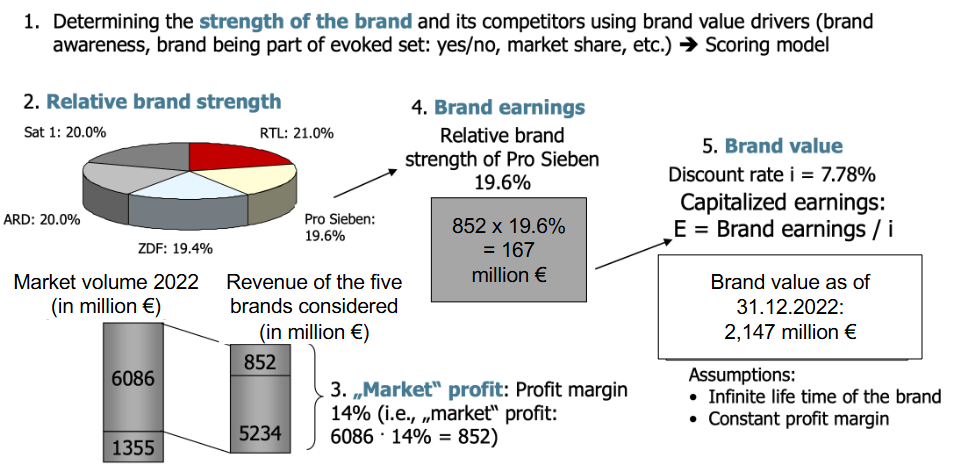
The brand value chain: A structured approach to
assess the sources and outcomes of brand equity
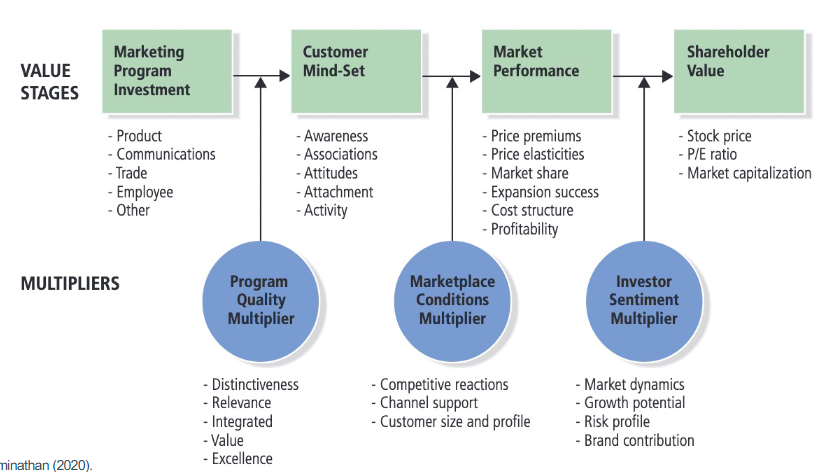
elasticity
elasticity = Percentage change in an outcome variable if an input variable is
increased by 1%.
Taking the brand value chain to empirical analysis:
The financial brand value chain including feedback

A short overview of brand equity-shareholder value
studies (2001 – 2008)
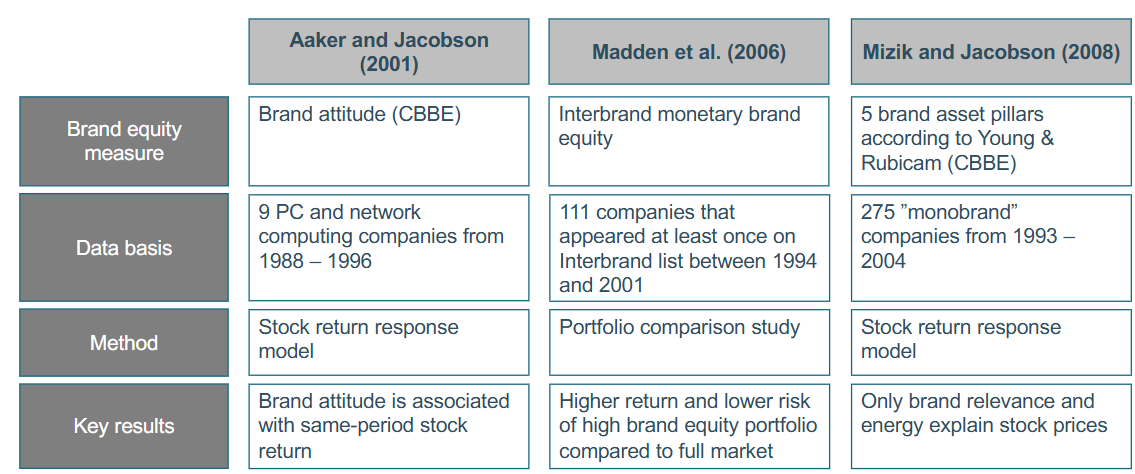
A short overview of brand equity-shareholder value
studies (2012– 2016)
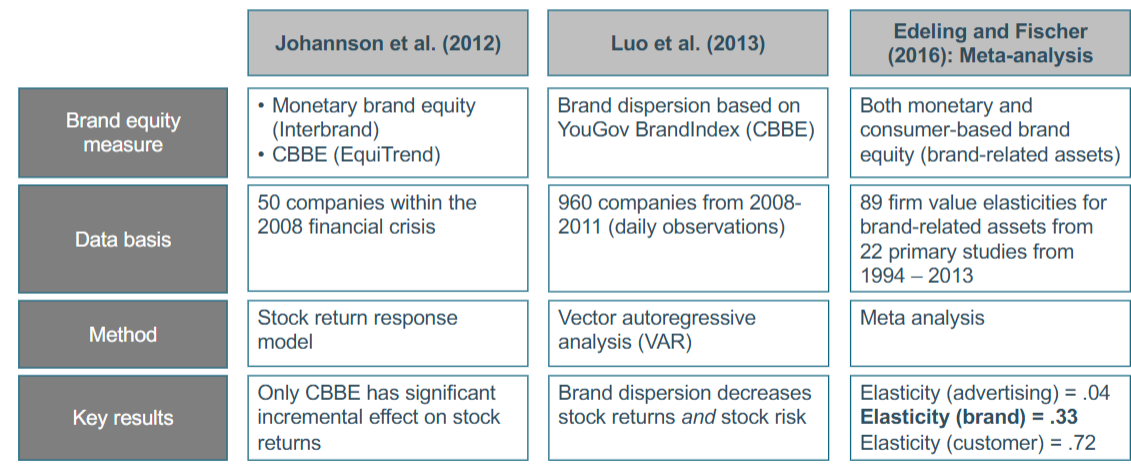
You can invest in brand equity
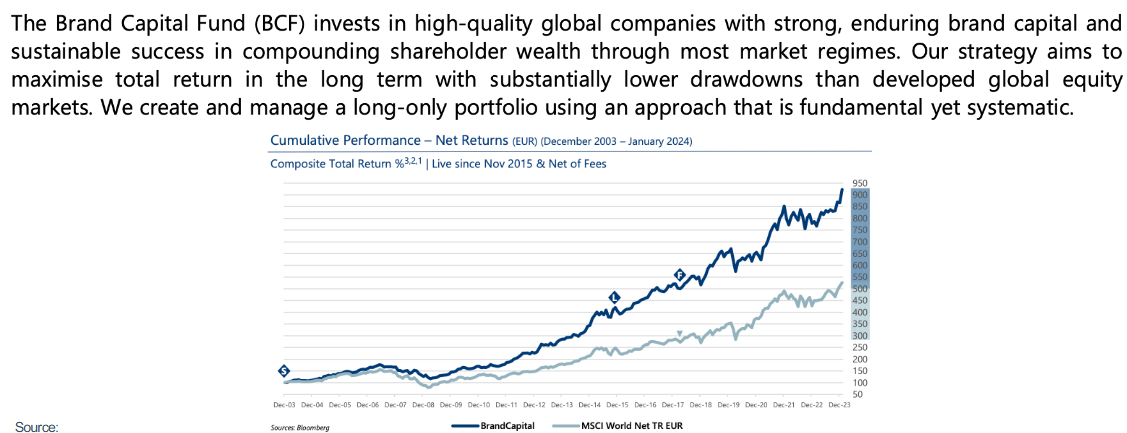
The new role of the consumer
The digital transformation offers a host of new ways for consumers to
• communicate with each other and with brands
• gather and exchange information about brands and products
• obtain and consume them
• Consumers have extensive options for being active and becoming engaged
• Digital (social) media has led to an “empowerment” of the consumer which
makes him an active participant in the brand management process
from bowling to pinball model
In the era of new media, managing customer relationships is like playing pinball – companies serve up a ‘‘marketing ball’’ (brands and brand-building messages) into a cacophonous environment, which is then diverted and
often accelerated by new media ‘‘bumpers,’’ which change the offering’s course in chaotic ways. After the marketing ball is in play, marketing managers continue to guide it with agile use of the ‘‘flippers,’’ but the ball does
not always go where it is intended to and the slightest miscue can be amplified into a catastrophic crisis.
The “Pinball Effect” of digital social media is a metaphor used to describe how information, ideas, and users ricochet unpredictably through digital platforms

Social media firestorms as a new, digital form of brand crises
• Social media firestorm = “sudden occurrence of many, predominantly
negative social media expressions against a brand” - like pepsi kendall ad
Harms brand perceptions in the short and in the long run, particularly if:
• initiated by vivid trigger
• linked to product/service or social failure
• large volume of social media messages
• the firestorm lasts longer
Brand identity vs. brand image
• Brand identity is
“a unique set of brand associations that the brand strategist aspires to
create or maintain. These associations represent what the brand stands
for and imply a promise to customers from the organization members”
• The brand identity reflects the target position of a brand as developed by the
firm and thus provides the basis for brand positioning.
• The brand image reflects the actual position as perceived by the customers.
What is brand positioning?
• Brand positioning communicates the brand identity to consumers
• Brand positioning ”is the act of designing the company’s offering and image to occupy a
distinctive place in the mind of the target market”
• The resulting brand image is a means to check whether the brand positioning reflects the desired brand identity
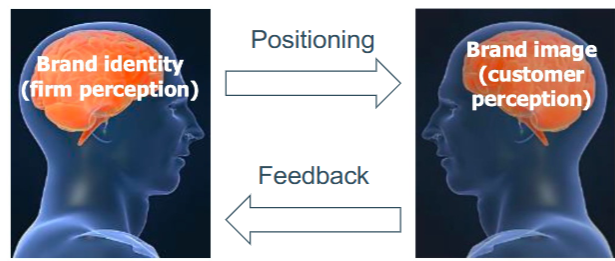
How to approach brand positioning
For deciding on a brand‘s positioning, managers need to know
1. Who the target market is.
2. Who the main competitors of the brand are.
3. How the brand is similar to these main competitors.
4. How the brand is different from these main competitors.
Target market
• Consumers differ in their perceptions, attitudes, and behaviors and thus in
their brand preferences
• A market segmentation is helpful to divide consumers in homogenous
groups with similar needs and behaviours
Main competitors
The decision on who to target implies more or less automatically the nature of
the competition
Points-of-parity
• Points-of-parity are associations that are not necessarily unique to the
brand, but that are shared with other brands.
• Such shared associations can help to establish category/segment
membership.
• Being “good enough” on certain dimensions; unless these points-of-parity
associations are achieved, other associations may not even matter.
Points-of-difference
• A brand must provide compelling and credible reasons for choosing it over competitor brands (USP).
• Points-of-difference are favourable attributes or benefits consumers strongly associate with a brand and for which they believe that competitor brands do not offer these attributes/benefits to the same extent.
• The aim is to distinguish the brand from competitor brands with respect to salient associations.
Choosing points-of-difference
• To serve as a point-of-difference the brand association must be desirable and deliverable.
Desirability criteria (consumer perspective)
• Consumers must find the association relevant
• Consumers must find the association distinctive (i.e., no other brand offers it to the same
extent) and superior
• Consumers must find the association believable
Deliverability criteria (company perspective)
• Feasibility (company’s ability to supply the attribute or benefit underlying the POD)
• Communicability (company’s ability to provide support for the POD claim)
• Sustainability (i.e., competitors should not be able to immediately copycat the attribute or
benefit)
Selecting a Brand Positioning
Two important factors for choosing a brand positioning are
• Consumers’ cognitive involvement
• Consumers’ emotional involvement
• The higher the cognitive involvement, the more is the consumer willing to
actively search and process information regarding the product/brand
• The higher the emotional involvement, the more is the consumer interested
in the brand’s personality
Selecting a brand positioning
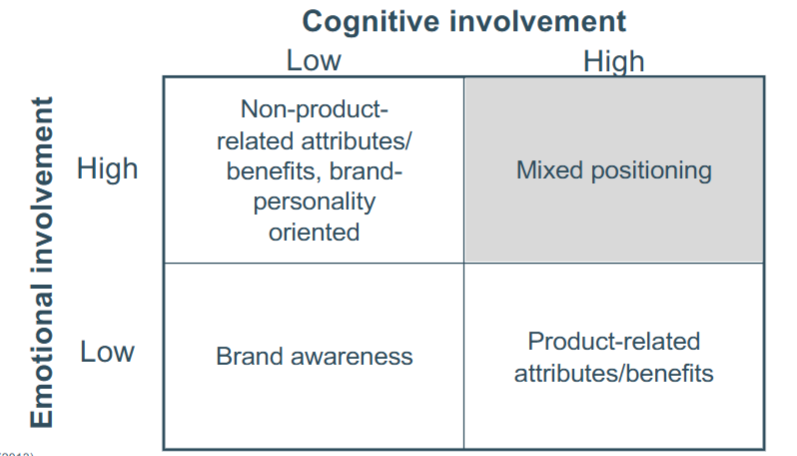
Brand elements
Brand elements are trademarkable devices that serve to identify the brand
and differentiate it
• Brand elements aim at enhancing brand awareness and facilitating a strong,
favourable, and unique brand image
• Brands often employ a broad range of brand elements
name, logo, slogan, symbols, packaging
Goals and criteria for choosing brand elements
Brand elements facilitate (a) building brand equity of new brands and (b)
leveraging and maintaining brand equity of existing brands
Building brand equity
• Memorability (to facilitate brand recall/recognition)
• Meaningfulness (to convey information about the function of the product or about particular attributes/benefits of the brand)
• Likability (in visual, verbal, or other ways)
Leveraging and maintaining brand equity
• Transferability (e.g., to new categories or new (geographic) markets/languages)
• Adaptability over time (to update it, e.g., in order to remain contemporary
Protectability (to legally protect the brand) à remember ”genericide” from Chapter 1
Brand name
• A brand name is the foundation of a brand‘s image
• It captures the central theme of the branded product(s) or its (their) key
associations in a very compact manner
• The brand name is also the most difficult brand element for managers to
change, because it is closely tied to the product in consumers’ minds
Findings and guidelines for developing brand names
• Simplicity and ease of spelling reduce processing efforts and facilitate recall
• Meaningful and familiar brand names lead to higher recall
• On the other hand, to facilitate recognition, brand names should be distinct and unique
• More complex brand names are more easily recognized because it is easier for consumers to
discriminate them
• Distinctive words: seldomly used or being atypical for the product category, unusual
combinations of words, completely made-up words
The sound of brand names
• Sound symbolism: The basic idea is that the mere sound of a word conveys
meaning and thus may automatically and unconsciously influence
consumers’ perceptions of product attributes and their brand evaluation
Empirical knowledge regarding brand linguistics (1)
• Sound repetition in a brand, when spoken out loud, has positive effects on
affect, brand evaluation, reactions to cross selling, and product choice
• Lower-case (upper-case) brand names are associated with feminine
(masculine) characteristics, and matching brand case with consumption
gender improves consumer responses
• Femininity is further affected by word length, ending sounds, and position of
stress, increasing brand warmth and brand outcomes (attitudes, choice, and
performance)
Empirical knowledge regarding brand linguistics (2)
• Unconventional spellings in brand names (e.g., Lyft instead of Lift) leads to
lower consumer support for unfamiliar brands
• Reason: Perception of choice as an overt persuasion attempt, so that brand is
regarded as less sincere
• Mechanism: Persuasion knowledge (Do you know what this could be?)
• Solution: Communicating a sincere naming origin story during introductory
marketing campaigns
• Exception: Unconventional spellings are desirable when consumers seek a
memorable experience
The effect of facial expressions in product design
like in cars
• People often see faces or parts of faces (e.g., eyes, mouth) on products or,
more generally, on inanimate objects
• ... and attribute humanlike characteristics and behavior to these objects
• Headlights → Eyes“ (arched vs. slanted)
• Grille → Mouth“ (upturned vs. downturned)
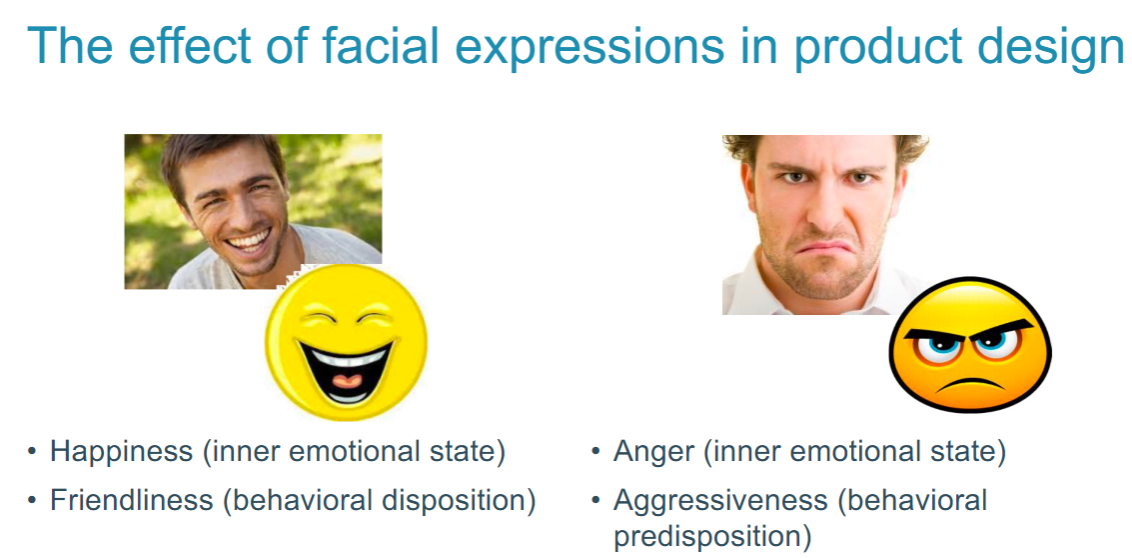
The brand value chain
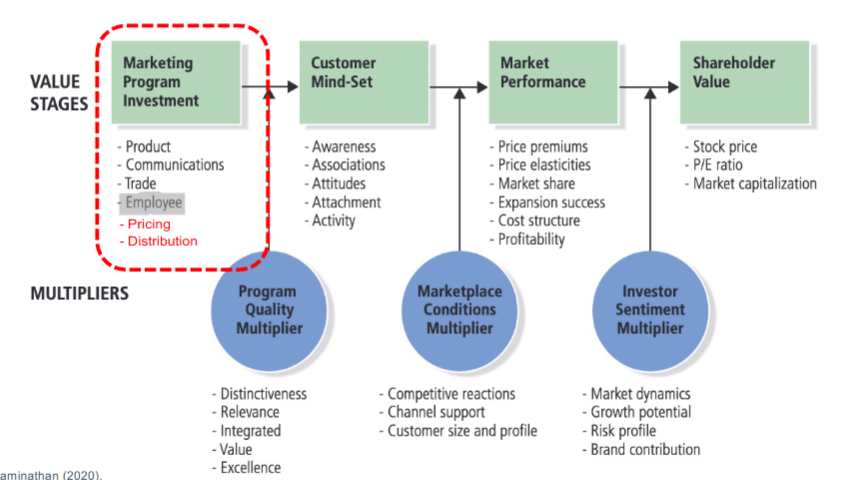
Perceived product quality as an important concept in
product strategy
• Perceived quality = “Customers’ perceptions of the overall quality or
superiority of a product or service compared with alternatives and with respect
to its intended purpose”
• Dimensions: Primary ingredients and supplementary features, product
reliability, durability, serviceability, style and design
• Relationship between objective and perceived quality
• Objective quality changes do not result in quick changes in perceived quality
• Effects are larger and quicker for a decrease than for an increase in quality
• Brand reputation speeds up perceived quality rewards and slows down perceived quality
punishments
Managing customers post-purchase
• “Second moment of truth”
• Actual product experiences convey most favorable associations, so that
“aftermarketing” becomes more and more important

User manuals as hidden potential for quality
perceptions
• User manuals are a neglected issue with often overly technical terms,
convoluted language and bad translations
• Better: Clearly describe what the product/service can do and how consumers
can realize the full (and not only the basic) benefits
• Augment offline manuals with online and multimedia formats
Customer service programs as an aftermarket tool
Customer service programs can go beyond call centers and online chat bots:
Brand communities
Benefits of good customer service programs:
• Connecting with customers
• Gain valuable feedback
• Cross-selling
• Up-selling
• Increased profitability
Bad customer service can lead to significant negative publicity (see
“firestorms”)
Loyalty programs to create strong ties with customers
• Purpose: “Identifying, maintaining and increasing the yield from a firm’s ‘best’
customers through long-term, interactive, value-added relationships”
• Company-specific (e.g., Airline) vs. industry-specific loyalty programs (e.g.,
myShopi)

The importance of pricing for company profits
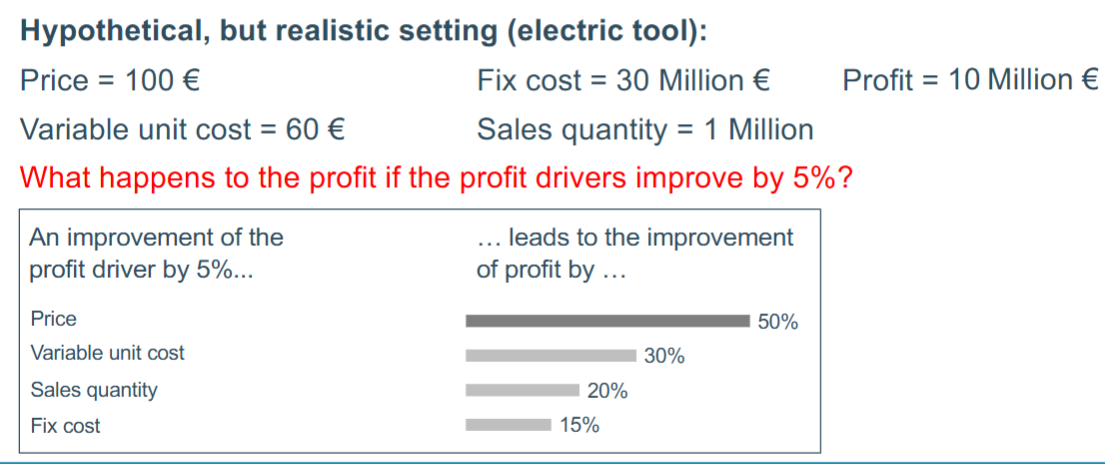
The importance of pricing for company profits (2)
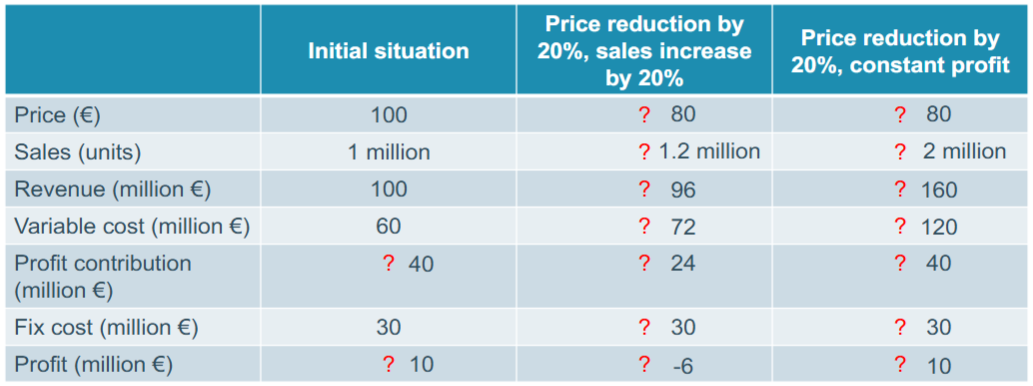
The 5 fundamental price positions
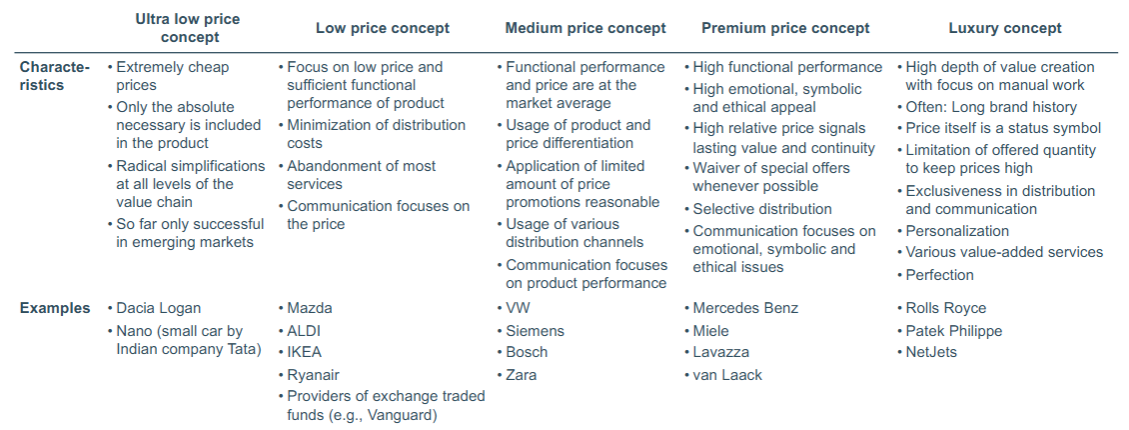
The concept of value pricing
• Irrespective of the price position, value pricing is a useful tool for customers as it helps to find the right combination of product quality, product costs and
product prices to fully satisfy customer preferences and profit targets of firms.
Necessary parallel activities:
• Communicating value
• Price segmentation

Every-day-low pricing
Price discounts have potential negative consequences
• High necessary sales quantity increases to make up for the profit contribution loss (see
above)
• Discount price could act as a new reference price for consumers, so that a return to the old
“standard” price is perceived as a loss
Every-day-low price as a way to prevent such negative price spirals:
• Avoids sawtooth pattern of alternating price increases and decreases
• Maintaining consistently low prices on major items every day helps build brand loyalty, fend
off private-label competition, and reduces manufacturing and inventory cost
Examples: IKEA, Aldi, Procter and Gamble (do you know any more?)
Negative consequences of a too aggressive discount
strategy: The German DIY chain Praktiker
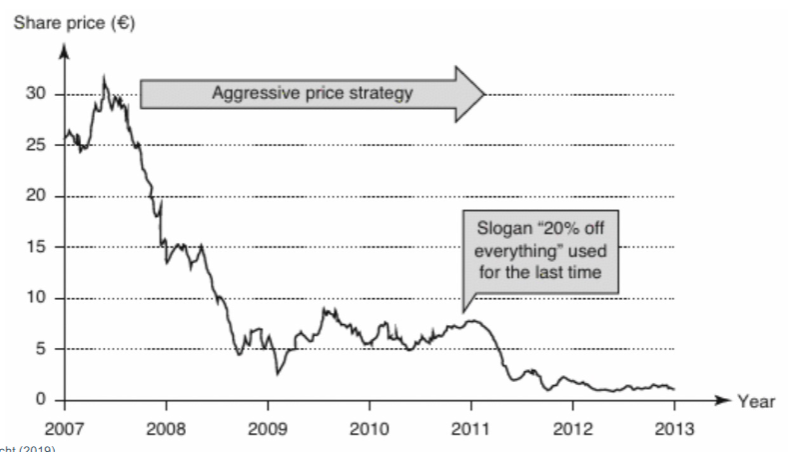
The “razor-and-blades” pricing strategy
• Selling the core, durable product component at a very low price
• Selling the additional, nondurable product components at a rather high price
+ Creating a locked-in situation with high switching cost à Brand loyalty
– Creating a locked-in situation with high switching cost à Customer frustration

Omnichannel retailing by Nike
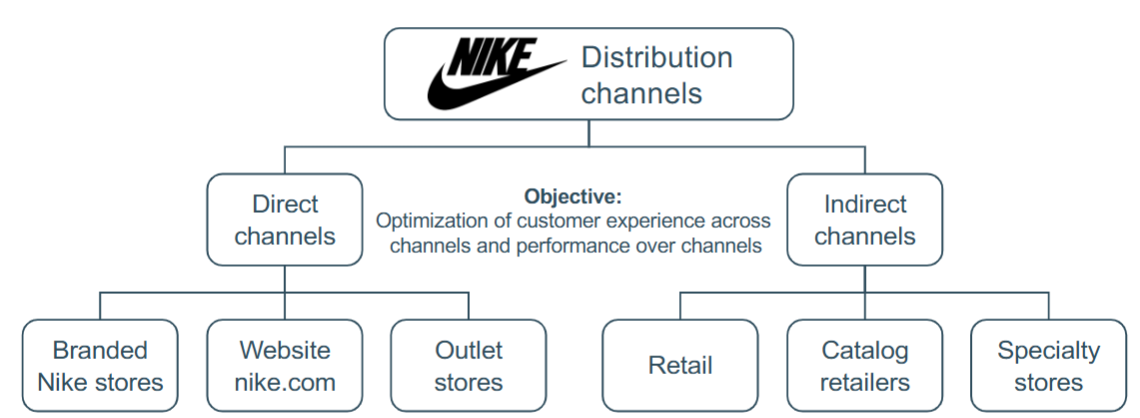
The choice between direct vs. indirect channels
Choice depends on transaction cost considerations
Direct channels are beneficial
• if the product is highly customized and very complex
• if demand is very concentrated on a relatively small number of customers
• if the monetary value of the product is large
• if establishing close relationships is warranted
• if sales activities should be monitored strongly
Nevertheless, the internet has forced brands to re-evaluate direct channels in
terms of transaction cost factors
Types of direct channels including pro’s and con’s
Company-owned stores (and pop-up stores)
+ Gaining control over selling process
+ Showing depth and breadth of product range
+ Experiences and tourist attractions bolster brand equity
– Lacking skills, resources and contacts to operate as retailer
– Potential conflict with channel partners
Store-within-store
+ Appeasing retailers
+ Retain control over product presentation
+ Quick distribution growth
+ Upgrading of image for established retailers (e.g., Sears and Forever 21)
– Often smaller assortment than in company-owned store
Online store
+ Shopping when and how consumers want
+ Allowing for cross-channel synergies (e.g., ordering online and picking up offline or vice versa)
+ Data about consumers
- High return rates decrease profit margins and are an ecological problem
Brand activities within indirect channels
Pull and push strategies
• Pull strategy = devoting marketing efforts to the end consumers who demand that retailers stock the brands’ products
• Push strategy = providing direct incentives for retailers to stock and sell products to end consumers
• Optimal: Blending of both strategies
Retail segmentation
• Retailers are customers too which need to be segmented or even treated individually
• Different product mixes
• Special delivery systems
• Customized promotions
• Even own branded versions of products
Cooperative advertising
• Manufacturer pays for a portion of the advertising that a retailer runs to
promote the manufacturer’s product
• Usually, the share is 50:50
• Rationale for brands: Concentrating some of the communication effort at the local level where the relevance and selling impact is greatest
Brands can choose from a large tool box of marketing
communication options
Highly complex in terms of integration of communication instruments and
decision about communication budget allocation.

The distinction between paid, owned and earned
online communication
Aim of many digital communication activities: Increasing brand engagement = “level of a customer’s cognitive, emotional, and behavioral investment in specific brand interactions’’
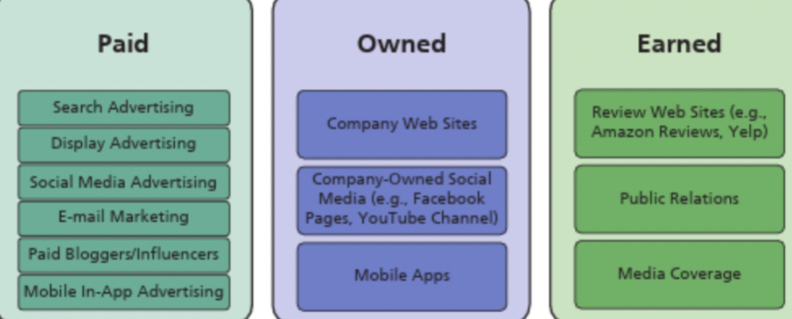
Why is it so hard to change consumer behavior by
communication? The information processing model
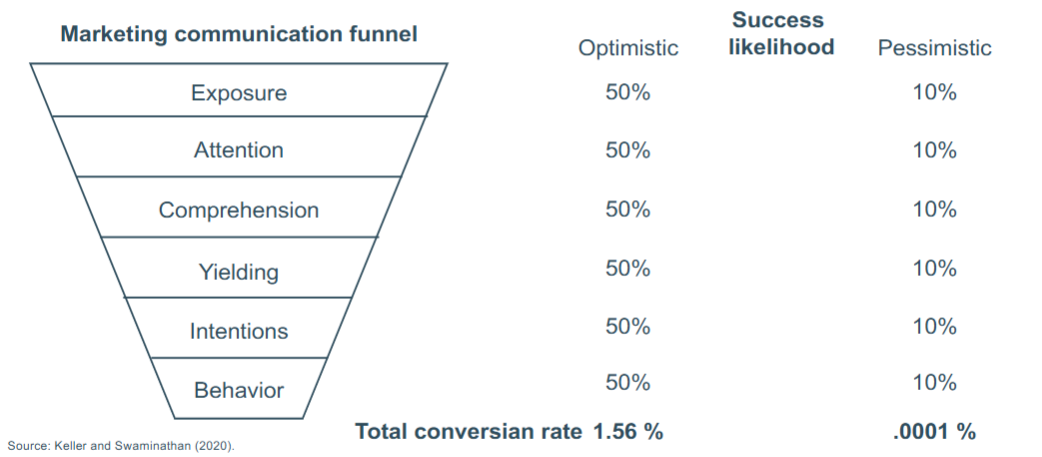
Criteria for integrated marketing communication
programs
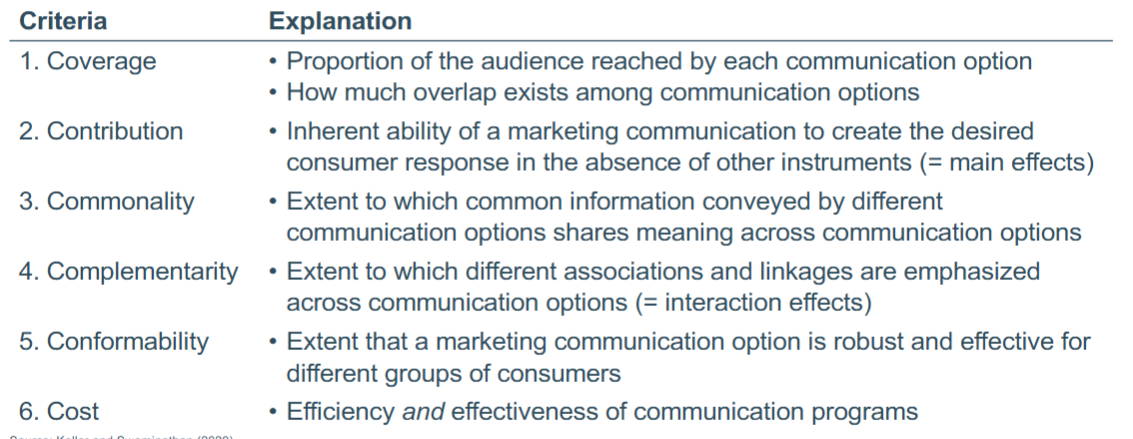
Dynamic, optimal communication budget allocation
across products and countries
• Research question: How should a communication budget be allocated across
different products, marketing activities and countries?
• Background: An optimal allocation of marketing spending is often more profit-
relevant than an optimal overall budget
Profit maximization problem
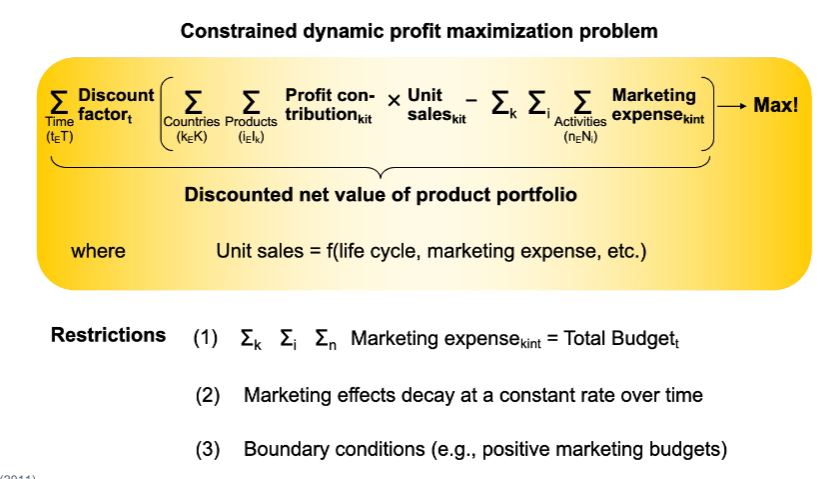
Solution to profit maximization problem
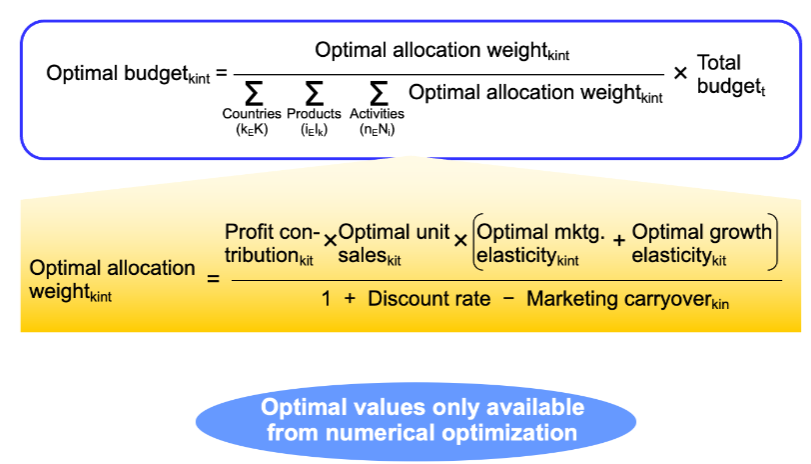
Heuristic solution for profit maximization problem
